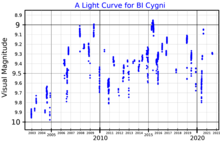BI Cygni (BI Cyg, IRC +40408, BD+36 4025) is a red supergiant in the constellation Cygnus. It is an irregular variable star with a maximum brightness of magnitude 8.4 and a minimum of magnitude 9.9. It is considered a member of the stellar Cygnus OB1 association,[4] its distance is around 2,600 parsecs (8,500 ly) of the Solar System. It is less than a degree south of another variable red supergiant, BC Cygni.
BI Cygni is the small very red dot right on the left edge of this image. The bright star at the centre is γ Cygni and north is to the right. Credit: Erik Larsen | |
| Observation data Epoch J2000 Equinox J2000 | |
|---|---|
| Constellation | Cygnus |
| Right ascension | 20h 21m 21.8869s[1] |
| Declination | 36° 55′ 55.729″[1] |
| Apparent magnitude (V) | 8.4 - 9.9[2] |
| Characteristics | |
| Spectral type | M4 Iab[2] |
| Variable type | Lc[2] |
| Astrometry | |
| Proper motion (μ) | RA: −2.751[1] mas/yr Dec.: −5.459[1] mas/yr |
| Parallax (π) | 0.3541 ± 0.0377 mas[1] |
| Distance | 2,579+232 −226[3] pc |
| Absolute magnitude (MV) | −6.78[4] |
| Details | |
| Mass | 17[5] M☉ |
| Radius | 852+12 −9 – 908+12 −10[6] R☉ |
| Luminosity | 89,300[5] L☉ |
| Surface gravity (log g) | -0.35[7] cgs |
| Temperature | 3,575[6][5] K |
| Metallicity [Fe/H] | +0.40[7] dex |
| Age | >12[5] Myr |
| Other designations | |
| Database references | |
| SIMBAD | data |

BI Cyg is a slow irregular variable star classified as type Lc, an irregular supergiant. Its brightness changes between extremes of magnitude 8.4 and 9.9.[2] Frequency analysis of its light curve shows no significant periods.[9]
BI Cyg is one of the largest known stars with a radius around 850 R☉, measured by its angular diameter by the CHARA array.[6] It is about 90,000 times more luminous that the Sun and has a cool effective temperature of 3,535 K.[5] Its mass is estimated at 17 solar masses, and it took 12 million years to enter the red supergiant phase.[5]
See also edit
Notes edit
References edit
- ^ a b c d e Vallenari, A.; et al. (Gaia collaboration) (2023). "Gaia Data Release 3. Summary of the content and survey properties". Astronomy and Astrophysics. 674: A1. arXiv:2208.00211. Bibcode:2023A&A...674A...1G. doi:10.1051/0004-6361/202243940. S2CID 244398875. Gaia DR3 record for this source at VizieR.
- ^ a b c d Samus, N. N.; Durlevich, O. V.; et al. (2009). "VizieR Online Data Catalog: General Catalogue of Variable Stars (Samus+ 2007-2013)". VizieR On-line Data Catalog: B/GCVS. Originally Published in: 2009yCat....102025S. 1. Bibcode:2009yCat....102025S.
- ^ Bailer-Jones, C. A. L.; Rybizki, J.; Fouesneau, M.; Demleitner, M.; Andrae, R. (2021). "Estimating Distances from Parallaxes. V. Geometric and Photogeometric Distances to 1.47 Billion Stars in Gaia Early Data Release 3". The Astronomical Journal. 161 (3): 147. arXiv:2012.05220. Bibcode:2021AJ....161..147B. doi:10.3847/1538-3881/abd806. S2CID 228063812.
- ^ a b Table 4 in Levesque, Emily M.; Massey, Philip; Olsen, K. A. G.; Plez, Bertrand; Josselin, Eric; Maeder, Andre; Meynet, Georges (August 2005). "The Effective Temperature Scale of Galactic Red Supergiants: Cool, but Not As Cool As We Thought". The Astrophysical Journal. 628 (2): 973–985. arXiv:astro-ph/0504337. Bibcode:2005ApJ...628..973L. doi:10.1086/430901. S2CID 15109583.
- ^ a b c d e f Comerón, F.; Djupvik, A. A.; Schneider, N.; Pasquali, A. (October 2020). "The historical record of massive star formation in Cygnus". Astronomy & Astrophysics. 2009: A62. arXiv:2009.12779. Bibcode:2020A&A...644A..62C. doi:10.1051/0004-6361/202039188. S2CID 221970180.
- ^ a b c Norris, Ryan P. (2019). Seeing Stars Like Never Before: A Long-term Interferometric Imaging Survey of Red Supergiants (PDF) (PhD). Georgia State University.
- ^ a b Anders, F.; Khalatyan, A.; Chiappini, C.; Queiroz, A. B.; Santiago, B. X.; Jordi, C.; Girardi, L.; Brown, A. G. A.; Matijevič, G.; Monari, G.; Cantat-Gaudin, T.; Weiler, M.; Khan, S.; Miglio, A.; Carrillo, I.; Romero-Gómez, M.; Minchev, I.; De Jong, R. S.; Antoja, T.; Ramos, P.; Steinmetz, M.; Enke, H. (2019). "Photo-astrometric distances, extinctions, and astrophysical parameters for Gaia DR2 stars brighter than G = 18". Astronomy and Astrophysics. 628: A94. arXiv:1904.11302. Bibcode:2019A&A...628A..94A. doi:10.1051/0004-6361/201935765. S2CID 131780028.
- ^ "OMC Archive". OMC Archive. The Astronomical Data Centre at CAB. Retrieved 19 December 2021.
- ^ Kiss, L. L; Szabó, Gy. M; Bedding, T. R (2006). "Variability in red supergiant stars: Pulsations, long secondary periods and convection noise". Monthly Notices of the Royal Astronomical Society. 372 (4): 1721–1734. arXiv:astro-ph/0608438. Bibcode:2006MNRAS.372.1721K. doi:10.1111/j.1365-2966.2006.10973.x. S2CID 5203133.
